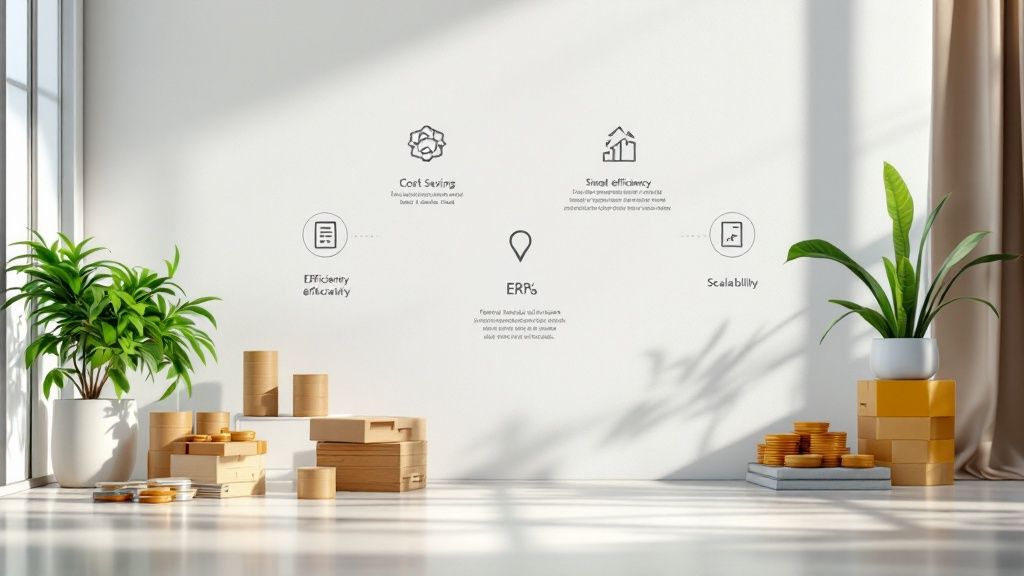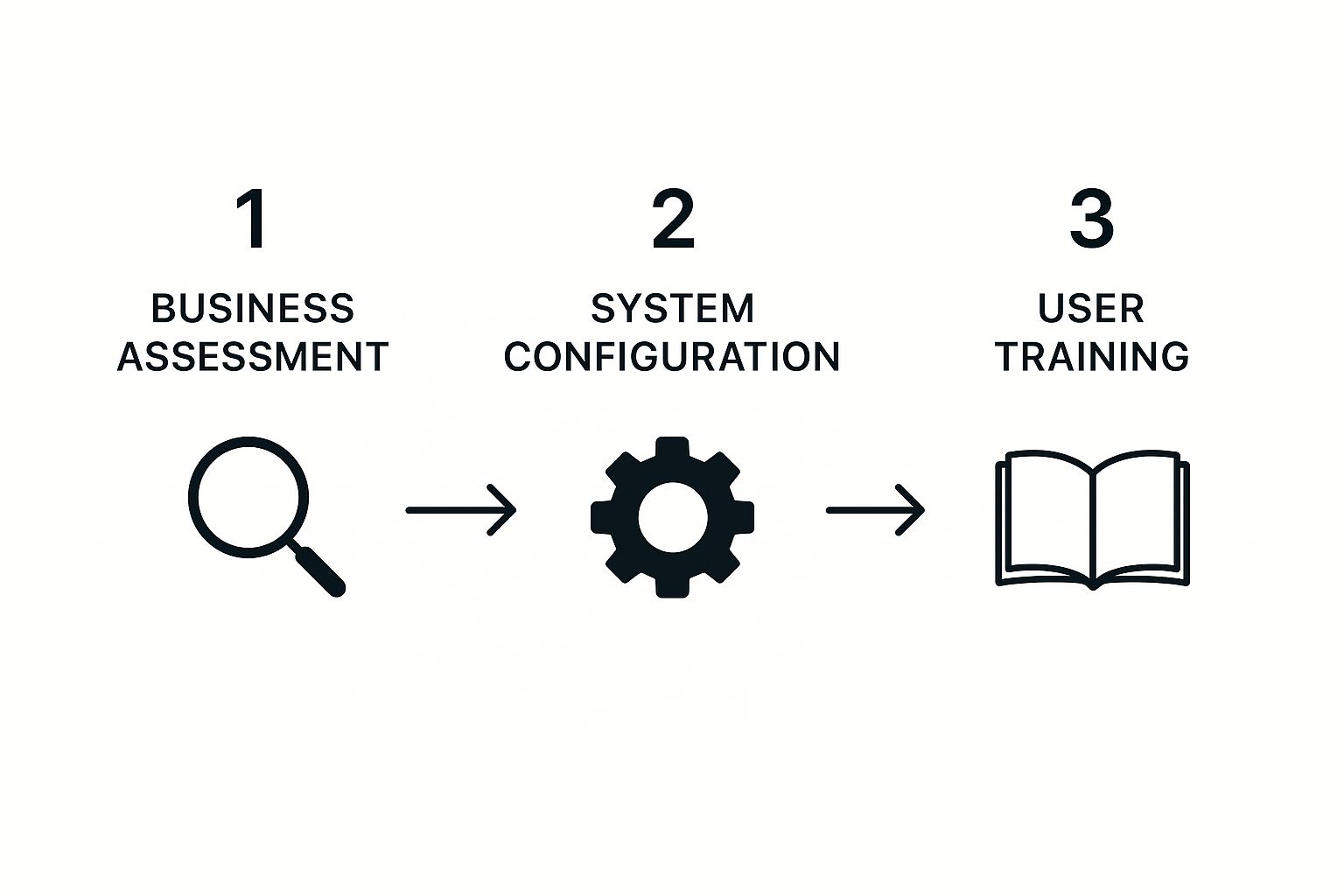Custom software development costs is a powerful, all-in-one business management solution built to integrate and manage a company’s core processes. It works as a single, unified platform, which means you can finally stop juggling a dozen disconnected apps for things like sales, inventory, accounting, and HR.
In short, it’s a complete suite of business tools designed to work together right out of the box.
What Is Odoo and Why Is It a Game Changer?
Picture your business as a well-organised orchestra. Each department—sales, accounting, inventory, customer service—has a vital role to play. But what happens if the string section can’t hear the brass, and the percussion is playing a completely different tune? That’s exactly what happens when businesses rely on separate, disjointed software.
One system manages sales, another handles the warehouse, and a third tracks the money. The result is data chaos.
This is precisely the problem Odoo ERP software was designed to solve. Don’t think of it as just another piece of software; see it as the central nervous system for your entire company. It creates a single source of truth where every department sees the same real-time information.
When a salesperson closes a deal, the inventory team gets an instant heads-up to prepare the shipment, and the accounting department automatically generates the invoice. No more manual updates, no more confusion.
The Power of a Modular Approach
What really makes Odoo stand out is its unique modular design. Traditional, old-school ERPs demand a massive, all-or-nothing implementation that can cripple a business. Odoo is different. It lets you start small and scale intelligently.
You can begin with just one or two critical applications—like Invoicing and Sales—and then add more modules as your business grows and your needs change.
This flexibility makes advanced ERP capabilities accessible to businesses of all sizes, especially in a dynamic market like India. Instead of a scary, company-wide overhaul, you can digitise your operations one step at a time. This guarantees a smoother transition and a much faster return on your investment. The ability to tailor the system to your exact needs is a huge advantage when you compare Odoo ERP with traditional systems.
The platform’s main dashboard gives you a clean, customisable view of all your key business activities.
This visual interface pulls data from all your different apps, giving you a high-level overview of performance at a single glance.
A Rapidly Growing Solution in India
Odoo’s practical and affordable approach is fuelling its remarkable rise in India. The platform has gone from being a niche open-source tool to a mainstream solution for serious enterprises.
As of Q2 2025, India is home to 5,381 active Odoo-powered stores. That represents an incredible 163% year-over-year increase in adoption. This growth shows just how many Indian retailers and service providers are choosing integrated platforms to run their businesses more efficiently.
Exploring The Core Modules That Power Your Business

To really get what makes erp software odoo tick, you have to look past the technical buzzwords and see its modules for what they are: solutions to real-world business headaches.
Think of these modules less like separate bits of software and more like specialised teams inside your company. Except these teams talk to each other perfectly, 24/7, without any miscommunication.
This is where Odoo really pulls ahead of the pack. It breaks down the invisible walls—the “silos”—that usually keep departments from sharing information. The result is a smooth, continuous flow of data, giving you a single, clear picture of your entire business, from the first hello with a customer to the final delivery.
Let’s dig into how these core modules become the engine that drives your business forward.
The CRM Module: Your Relationship Engine
At the end of the day, business is all about relationships. The Odoo CRM (Customer Relationship Management) module is your command centre for keeping every single one of those relationships healthy and growing.
This is so much more than a glorified contact list. It’s a living, breathing tool for tracking leads, managing your sales pipeline, and actually understanding what your customers are thinking.
Picture this: a potential customer lands on your website and fills out an enquiry form. Instantly, a new lead pops up in your CRM. From that moment on, your sales team can log every single interaction—emails, calls, meetings—all in one place. No more digging through old inboxes. This creates a complete history, making sure every conversation is smart, relevant, and builds on the last one.
“A well-managed CRM is the difference between guessing what your customers want and knowing what they need. It turns raw data into actionable insights, empowering your sales team to build lasting, profitable relationships.”
For any business serious about maximising client interactions, it’s crucial to learn how to use Odoo CRM for effective customer relationships and turn every lead into a loyal fan. It’s how you stop just managing contacts and start actively growing your business.
The Inventory Module: Your Supply Chain Command Centre
If you deal with physical products, you know that managing inventory is a constant tightrope walk. Too much stock, and your cash is tied up on a shelf. Too little, and you’re dealing with lost sales and frustrated customers.
The Odoo Inventory module is the central nervous system for your entire supply chain, giving you real-time visibility and control.
From the second raw materials arrive to the moment a finished product ships out, every movement is tracked. The system can automatically set reordering points, manage stock across multiple warehouses, and even handle tricky processes like drop-shipping. This kind of automation is a game-changer, slashing manual errors and making sure your stock levels are always just right.
Best of all, it works hand-in-hand with the Sales and Accounting apps. When a sale goes through, inventory is updated automatically. When new stock comes in, the books are adjusted. It’s this seamless integration that guarantees your data is accurate across the board.
The Accounting Module: Your Financial Dashboard
The Odoo Accounting module is the financial heart of your company. It gives you a live, detailed view of your financial health—from cash flow and profitability to expenses and tax compliance.
It puts tedious tasks like bank reconciliation, invoicing, and payment follow-ups on autopilot. This frees up your team from mind-numbing data entry so they can focus on actual strategic financial planning.
Crucially, the module is built to handle the complexities of the Indian market, with full support for GST and other local regulations. It connects directly with your other modules to ensure every single business transaction is recorded accurately.
- Sales Integration: When an invoice is created in the Sales module, a matching entry is automatically generated in your accounting ledger.
- Purchase Integration: When you buy raw materials, the bill gets logged and the payment process is managed right from the accounting app.
- Expense Management: Employees can submit expenses for approval, and once given the green light, the reimbursement process is handled smoothly.
Here’s a quick look at some key Odoo modules and what they do.
Key Odoo Modules and Their Business Functions
| Module | Core Business Function | Key Features |
|---|---|---|
| CRM | Manages customer interactions and sales pipelines. | Lead tracking, sales pipeline management, activity logging, reporting. |
| Inventory | Controls and automates stock management. | Real-time tracking, multi-warehouse support, automated reordering. |
| Accounting | Handles all financial transactions and reporting. | Invoicing, bank reconciliation, expense tracking, GST compliance. |
| Manufacturing | Manages the entire production process. | Bill of Materials (BOMs), work orders, quality control, scheduling. |
| eCommerce | Builds and manages an online store. | Website builder, product catalogue, payment gateway integration. |
| Project | Organises and tracks project tasks and timelines. | Kanban boards, Gantt charts, timesheets, task delegation. |
This table just scratches the surface, but it shows how each module is designed to tackle a core part of running a business.
A Unified Ecosystem for Growth
Beyond these core apps, Odoo offers a huge library of modules to manage pretty much every part of your business, including Manufacturing, Project Management, eCommerce, and Human Resources.
Each app is designed to solve a specific business challenge while communicating flawlessly with all the others.
This creates a powerful, unified ecosystem where information moves freely. A project’s budget is tracked in Accounting, its tasks are managed in Project, and team members’ hours are logged through HR. This is the true magic of an integrated erp software odoo solution—it creates one version of the truth, allowing you to make smarter, data-driven decisions that fuel real, sustainable growth.
Choosing Between Odoo Community and Enterprise

One of the first, and most important, decisions you’ll face with this erp software odoo is picking between its two main flavours: Odoo Community and Odoo Enterprise. The best way to think about it is like building a house. Community gives you a plot of land and a solid set of blueprints, while Enterprise hands you the keys to a fully furnished, move-in-ready home with a maintenance crew on standby.
Both paths get you a roof over your head, but they’re built for very different needs, budgets, and how much hands-on work you’re willing to do. Getting this choice right lays the foundation for your entire business operation.
Understanding Odoo Community
Odoo Community is the open-source, completely free-to-download version. It’s not a “lite” version, either—it’s a powerful core system packed with essential modules like CRM, Sales, Invoicing, and a Website builder. It gives you more than enough to get a business off the ground and running efficiently.
This version is a fantastic fit for:
- Startups and Small Businesses: With zero licence fees, it’s an incredibly compelling option for companies watching every rupee.
- Companies with a Strong IT Team: If you have developers in-house or a trusted tech partner, you can customise and build on the Community edition to do almost anything you can imagine.
- Businesses with Really Unique Workflows: The open-source code means you can dig in and modify it to perfectly match your specific, non-standard processes.
But “free” doesn’t mean zero cost. With Community, you’re the one responsible for everything else: hosting, security, updates, and any custom work. Support comes from the global community through forums and online documentation, not a dedicated helpdesk.
Exploring Odoo Enterprise
Odoo Enterprise is the premium, subscription-based version. It includes every single feature from the Community edition and then piles on a whole suite of advanced modules, professional support, and hassle-free version upgrades. It’s designed for businesses that want a complete, worry-free solution right out of the box.
Enterprise is the clear choice for:
- Growing SMEs and Large Corporations: If you need more sophisticated tools for accounting, barcode scanning, or advanced manufacturing, you’ll find them only in the Enterprise edition.
- Companies That Need Guaranteed Support: Getting direct access to Odoo’s support team and your implementation partner is a massive advantage. It means problems get solved fast.
- Organisations Wanting a Managed Solution: Enterprise offers hosting on Odoo.sh or Odoo Online, which takes server management and maintenance completely off your to-do list.
The subscription cost is predictable, based on how many users you have and which apps you need. This makes it easy to scale your investment as your company grows.
A lot of businesses take a phased approach with Odoo. It’s quite common for Indian companies to start their journey on the free Community edition to keep initial costs low. As they scale up and their needs become more complex, they migrate over to Enterprise to get those advanced features and dedicated support. You can read more about Odoo’s high adoption rates in India on wesolved.com.
A Head-to-Head Comparison
To lay it out as clearly as possible, here’s a simple breakdown of the key differences.
| Feature | Odoo Community | Odoo Enterprise |
|---|---|---|
| Cost | Free software licence | Paid subscription (per user/app) |
| Core Functionality | Includes essential apps (Sales, CRM, etc.) | All Community features plus advanced modules |
| Advanced Features | Limited | Advanced Accounting, Barcode, MRP II |
| Support | Community forums and documentation | Direct support from Odoo and partners |
| Hosting | Self-hosted or third-party provider | Odoo Online, Odoo.sh, or self-hosted |
| Upgrades | Manual migration process | Automated, seamless version upgrades |
| User Interface | Functional desktop UI | Enhanced desktop and mobile UI |
In the end, there’s no single “best” version—only the one that’s right for your business. Take a hard look at your budget, your internal technical skills, and where you see your company in the next few years. If you’re a tech-savvy startup, Community is an incredible starting point. If you’re a growing business that can’t afford downtime and values premium tools, Enterprise is a smart investment in your future.
Navigating Your Odoo Implementation Journey
Bringing a powerful ERP into your business can feel like a massive undertaking, but it doesn’t have to be a blind leap of faith. Think of it like building a custom house. You wouldn’t just start throwing up walls without a detailed blueprint. A successful Odoo implementation follows a similar, structured path, breaking a complex project down into a series of manageable, logical steps.
For any business in India, this journey is about more than just installing software. It’s about moulding the powerful features of erp software odoo to fit unique local needs. This means ensuring seamless GST compliance, integrating with e-invoicing portals, and connecting to popular Indian payment gateways. A clear, well-defined roadmap is the key to a smooth and successful rollout.
The Foundational First Step: Analysis and Discovery
Before a single module is configured, the most important phase is understanding your business from the inside out. This isn’t just about what you do, but how and why you do it. The goal is to create a detailed map of your current workflows, pinpointing the bottlenecks, pain points, and areas that are screaming for an upgrade.
This stage is all about deep collaboration between your team and your implementation partner. Together, you’ll define the project’s scope, lock down clear objectives, and figure out which Odoo modules are must-haves to hit your goals. This ensures the final system is built to solve your actual problems, not just pave over old, inefficient processes.
The process flow below visualises these core stages.

As the visual shows, a successful project starts with a deep dive into business needs long before the technical work begins.
Configuration and Data Migration
With the blueprint finalised, the real technical work kicks off. This is where your implementation partner gets hands-on, configuring the Odoo modules to perfectly match your defined business processes. This phase typically includes:
- System Setup: Getting Odoo installed and tweaking the core settings to get things started.
- Customisation: Tailoring modules to fit your specific ways of working, like building custom reports or adding unique fields your team needs.
- Integration: A huge part of a successful Odoo journey involves mastering ERP systems integration with the other tech you already use. This could mean connecting Odoo to a biometric attendance system or a specialised machine on your factory floor.
Next up is data migration. This is the delicate process of moving your historical data—think customer lists, product catalogues, and past sales records—from your old, clunky systems into Odoo. Clean, accurate data is the lifeblood of any ERP, so this step is handled with extreme care to make sure you have a reliable “single source of truth” from day one. To keep everything on track, it’s always smart to follow established ERP implementation best practices.
Training and Go-Live
An ERP is only as good as the people who use it. That’s why comprehensive user training isn’t just a suggestion; it’s a non-negotiable step. The goal is to make sure your team feels confident and capable with the new system. Training should always be role-specific, showing each person exactly how Odoo is going to make their daily tasks easier and more efficient.
The “Go-Live” is the big moment—when you finally switch off your old systems and officially start running your business on Odoo. A well-planned launch is often done in phases to keep disruption to a minimum. After you’re live, your implementation partner sticks around to provide ongoing support, squashing any initial bugs and ensuring the system runs like a well-oiled machine.
Choosing the right implementation partner is arguably the most important decision you’ll make. A great partner is your guide, translator, and technical expert, making sure your Odoo implementation journey leads to real business growth and operational excellence.
What Odoo Can Actually Do For Your Business

Exploring modules and features is great, but let’s get down to brass tacks. What will Odoo really do for your bottom line? Adopting an ERP software Odoo solution is about driving measurable growth, not just shuffling your tech stack around.
The magic of Odoo lies in creating a single source of truth for your entire business. When every department—from the sales floor to the warehouse to the finance team—is working from the same real-time data, everything changes. The result? A massive drop in errors, a huge boost in efficiency, and a crystal-clear view of your whole operation.
Unify Your Operations And Tear Down Data Silos
The first thing you’ll notice with Odoo is the death of the data silo. You know the ones—those invisible walls that pop up between departments because everyone is using different, disconnected software. When your sales system has no idea what your inventory system is doing, you’re practically inviting chaos.
Odoo smashes those walls down. For example, the moment a sales order is confirmed in the CRM, the inventory app automatically reserves the stock, and the accounting app gets the invoice ready. This seamless flow of information means far less manual data entry, fewer mistakes, and more time for your team to focus on work that actually matters.
Achieve Remarkable Cost-Effectiveness
Let’s be honest: traditional ERP systems from giants like SAP or Oracle are famous for their eye-watering price tags and marathon implementation times. Odoo breaks that mould entirely, offering powerful functionality without the enterprise-level cost. For small and medium-sized businesses in India, its lower total cost of ownership is a massive win.
Thanks to its modular, open-source model, you can start with just the tools you need right now, keeping your initial investment manageable. To see the tangible benefits, just look at how Odoo works as one of the leading accounting automation tools, taking repetitive financial tasks off your plate and delivering a quick return on investment.
By automating key processes and providing a unified platform, Odoo reduces operational costs significantly. Studies have shown that businesses can see a 23% reduction in operational costs and a 22% cut in administrative costs after implementing a well-suited ERP system.
Scale And Customise As You Grow
Your business isn’t standing still, so why should your software? Odoo is built from the ground up to grow with you. Its modular architecture means you can bolt on new applications and features whenever you need them, whether you’re expanding your team or launching a new product line.
You might kick things off with just the Sales and Accounting modules. A year down the line, you could seamlessly add the Manufacturing module as you decide to bring production in-house. This incredible flexibility means you’ll never be trapped by a rigid system that can’t keep up with your ambition.
Make Smarter, Data-Driven Decisions
In business, knowledge is power. Odoo puts that power right at your fingertips with real-time analytics and customisable dashboards. Forget waiting for someone to compile messy spreadsheets for a monthly report; you get instant access to the key performance indicators (KPIs) that matter most.
With just a few clicks, you can track sales trends, keep an eye on inventory levels, and check the financial pulse of your company. This immediate access to accurate, live data empowers you to stop reacting and start making proactive, informed decisions that steer your business towards greater profitability.
Frequently Asked Questions About Odoo
Diving into a new business management platform like erp software odoo always brings up a few questions. It’s perfectly normal. For business owners in India, getting clear on the real costs, customisation potential, and whether it’s the right fit is crucial before you commit. This section cuts straight to the chase, answering the most common questions we hear every day.
We’ve pulled these insights directly from our experiences with businesses across all sorts of industries to tackle what really matters to you. Think of this as your practical guide to getting the clarity you need.
How Much Does Odoo ERP Software Cost in India?
There’s no simple price tag for Odoo, and that’s actually one of its strengths—it’s incredibly flexible. The Odoo Community version is completely free to download and use. Your main costs will be for things like hosting, the initial setup, and any ongoing support you might need, which is usually handled by an Odoo partner.
The Enterprise version works on a clear subscription model. The price depends on how many users you have and which specific apps you decide to turn on. For a small business, this could mean an investment of just a few thousand rupees a month, while a larger company with more complex needs will naturally see a higher cost.
The only way to get a truly accurate number is to talk to an official Odoo partner in India. They can dig into your specific needs, figure out what you actually require, and give you a detailed quote covering software licences, implementation, and any custom work.
Can Odoo Be Customised for My Specific Industry?
Absolutely. In fact, this is where Odoo really shines. Its open-source nature and modular design mean developers can tweak existing apps or build brand-new ones from scratch to match your unique way of doing business.
It doesn’t matter if you’re in manufacturing, retail, services, or a super-specialised niche; Odoo can be shaped to your exact needs. Many Indian partners are experts at creating industry-specific solutions, such as:
- Integrating directly with the GST network for painless tax compliance.
- Building custom workflows that align with local business practices and regulations.
- Connecting with specific hardware, like biometric attendance systems or specialised factory machinery.
This adaptability means the software works for you, not the other way around. It becomes a tool that fits your processes perfectly, making your team more efficient instead of forcing them to change how they work.
Is Odoo a Good Fit for Small Businesses in India?
Yes, Odoo is an fantastic choice for Indian Small and Medium-sized Enterprises (SMEs). What sets it apart from the big, clunky ERP systems of the past is its affordability and scalability. You can get started with the free Community edition and just switch on the modules you need right now, like Accounting and Sales.
This keeps your initial investment incredibly low, making it one of the most accessible platforms out there. Then, as your business grows, you can easily add more modules or upgrade to the Enterprise edition when you need more advanced features. This “pay-as-you-grow” approach lets SMEs digitise their operations without needing a massive upfront budget.
Ready to streamline your operations and unlock new growth potential with a tailored Odoo solution? At KP Infotech, we specialise in implementing and customising Odoo to meet the unique needs of Indian businesses. Contact us today for a free consultation and discover how we can transform your business.
